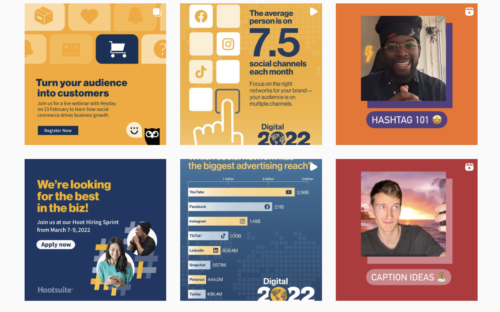Article's Content
MasterClass is one of the few unicorns in EdTech.
Valued at $2.75 billion, the company has attracted teaching talent like Shonda Rhimes, Spike Lee, Aaron Sorkin, Stephen Curry, Simone Biles, and more.
But what the company should really be applauded for is the master class they’re putting on regarding content and SEO.
Just take a look at these wild numbers 🤯:
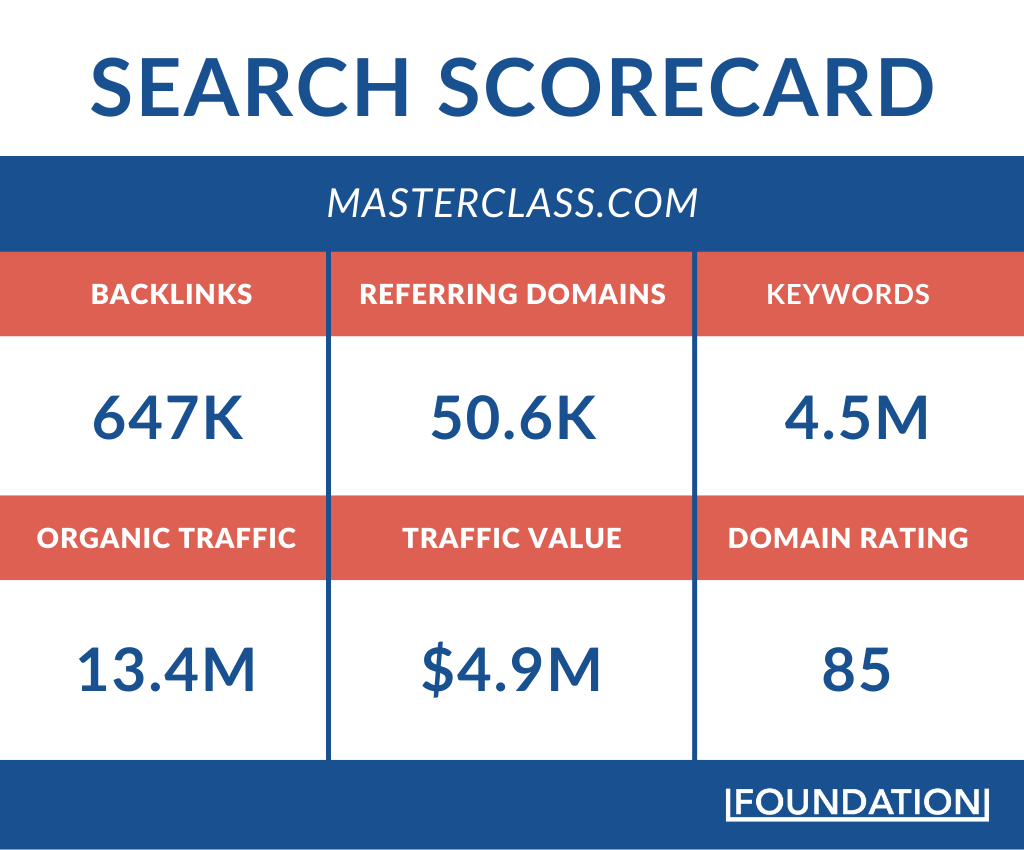
And let’s not forget social media:

But it’s not just social and traffic numbers—MasterClass sold 30,000 course sign-ups in the first four months alone!
You’ve got to admit, in a time of massive open online courses (MOOCs) where people are looking for what’s cheap rather than the premium experience, MasterClass is setting new standards for marketers everywhere. That, and giving older education platforms a run for their money.
But how is MasterClass achieving this level of success? Is it sheer luck? Celebrity power? Or is there a replicable strategy behind their success? Most of all, how can businesses with a lean marketing team get these same results (or close to it)?
We’ll be covering these questions and more in this MasterClass deep dive.
To be precise, you are going to get a complete breakdown of the MasterClass marketing strategy, which helped grow their brand a whopping 17,677% in 2020. You’ll also learn about some of our favorite ways to get more eyes on your content as a smaller team.
Finally, you’ll find out one unique content angle that MasterClass isn’t using that could be an absolute game-changer for industry early adopters.
Let’s dive in.
“I read every issue of the Foundation newsletter. The breakdowns are outstanding.”
– Brain Dean, Founder of Backlinko (acquired by SEMRush)
Leveraging Search Intent To Dominate the SERPs
MasterClass spends a lot on ads. You’ve seen them plastered all over Facebook, Instagram, YouTube…
Business Insider reports a $6.5 million ad spend in 2019—and the brand spent even more than that in March and April of 2020, as demand for its product increased.
Despite its massive ad budget, MasterClass’ biggest traffic driver for its website and app is search:
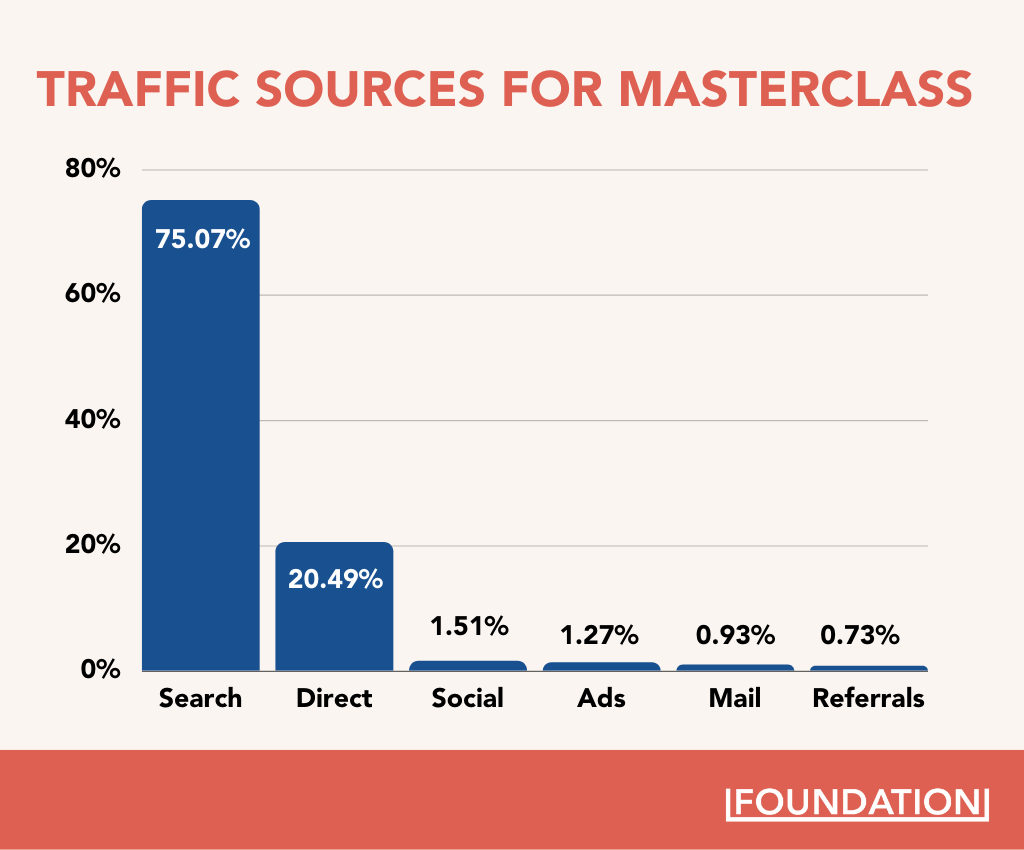
The brand ranks No. 1 for seemingly generic terms and long-tail keywords like:
- taro
- king size bed
- what colors make brown
…some of which have monthly search volumes of 100,000+ each.
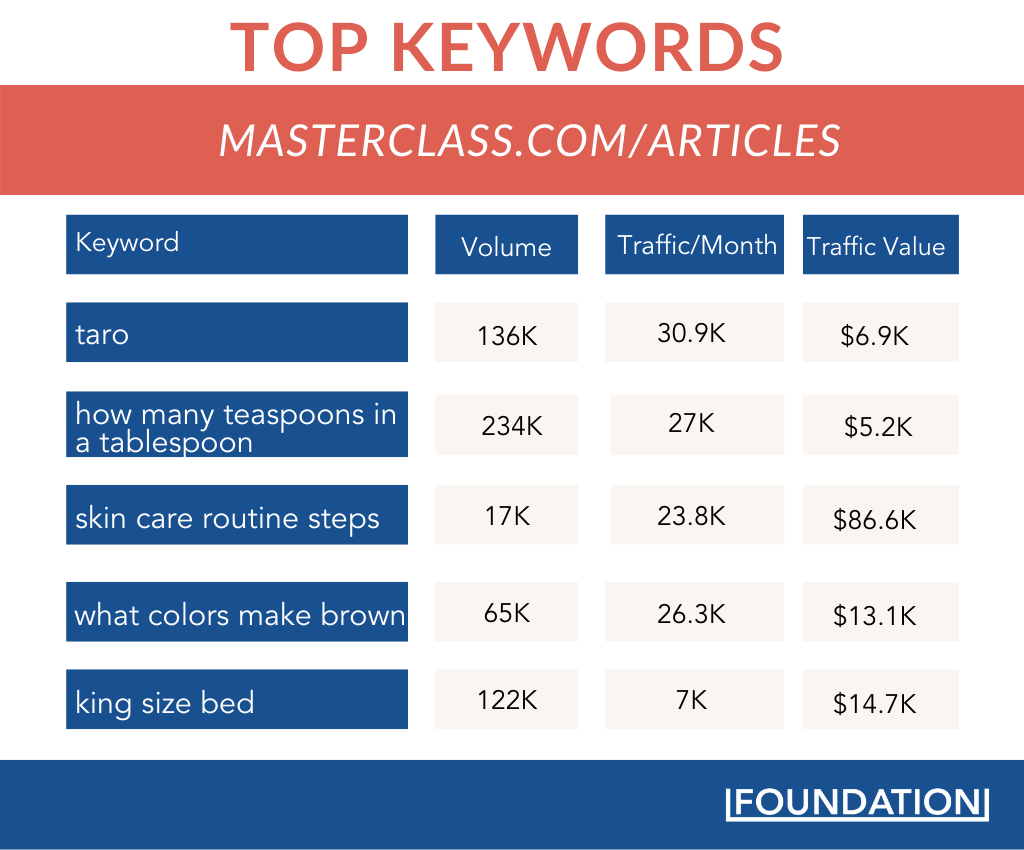
One thing is clear: They’ve mastered the power of satisfying search intent.
More than targeting high-volume keywords, the real key to driving organic traffic is creating content that aligns with the surfer’s search intent.
What Is Search Intent?
Search intent is the reason why a person searches for a specific query.
Is it because they want to learn something? To investigate something? To buy something? Or to get somewhere?
For example:
- What colors make brown? – to learn something (Informational intent)
- MasterClass vs. Mind Valley – to investigate something (Commercial investigational intent)
- MasterClass price – to buy something (Transactional intent)
- MasterClass – to get somewhere specific (Navigational intent)
There’s more and more evidence that points to the importance of understanding search intent if you want to rank.
For example, Canva uses different landing pages in response to different search intents for similar queries. Now, it’s pretty easy to understand search intent when you have modifiers like these to help.

But how do you understand the search intent behind generic, one-word searches like “shallots” and “fennel”?
Simple: Look at the SERPs.
Google will prioritize pages that satisfy the search intent, so looking at those ranking snippets will accurately reveal, 9 times out of 10, what people really want to see.
For example—shallots.
All the top-ranking pages for the search term “shallots” talk about the relationship between shallots and onions. Clearly, people are confused about shallots and are looking for some clarity.
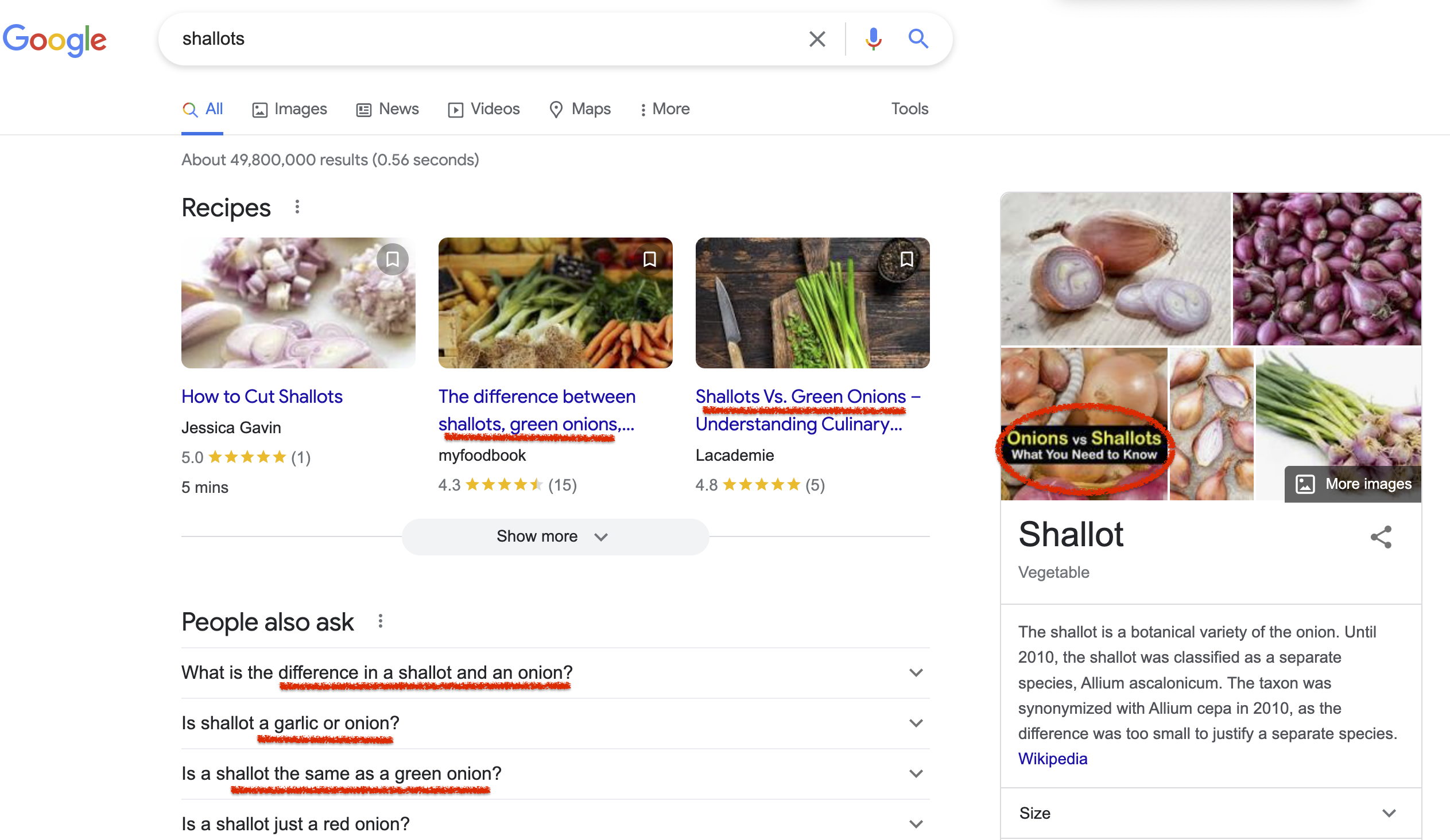
Even better, MasterClass takes this knowledge and improves on it using suggestions from the “People also ask” box.

Masterclass also uses these search queries from the “People Also Ask” box to create anchor links for its blog post:
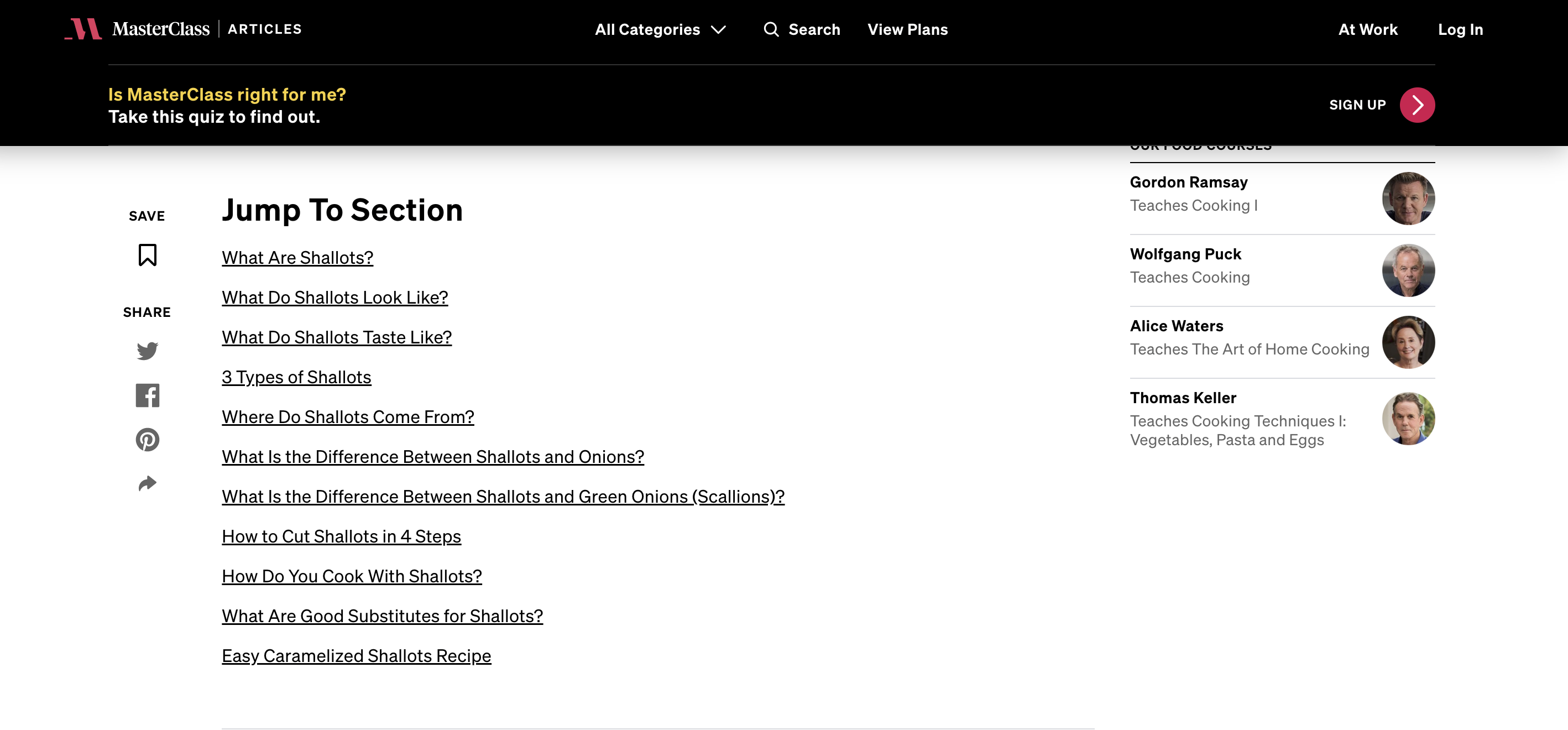
Anchor links are valuable because it helps readers navigate your content easily, especially for skimmers. They know where to find the details they need without spending minutes searching. Anchor links also help to boost your page’s organic rankings. It’s no wonder MasterClass ranks among the top five pages on the SERPs for the keyword “shallots,” “types of shallots,” and for other terms in its anchor links. Almost 14,000 people land on the page every month.
Focusing on Exceptional Content
But it’s not enough to simply match the intent of searchers. MasterClass’ blog content completely delights readers.
Here are four places where MasterClass stands out with content:
1. Actionable
When people search on Google, they are usually looking for help to take action correctly.
MasterClass’ blog posts give you more than information—they give you action steps. They don’t just tell you what to do, but also how to do it.

Here’s why that’s important:
Only when people are able to act on your content do they get results. And people remember results.
That’s the brand recognition that makes people look for your links, even when you are third in the SERPs.
2. Visually Stimulating
Did you notice something else in that last screenshot?
Images!
- They break up the post.
- They engage readers.
- They help with SEO.
The point is, effectively writing for the web is completely different from writing for print.
Focus on the UX as much as on keywords. That’s what MasterClass does.
3. Written for Skimmers
If you read the article we linked in the last section, you already know the importance of formatting with short paragraphs, headings, and lots of white space.
Most people will only read the introduction and headings from your blog posts, and most blogs today have already adapted to accommodate this change.
However, there’s something special about MasterClass’ blog content that you still don’t find in many other blog posts.
They’re straight to the point, with a hook.
Here’s the thing:
We learned to blog from hobby bloggers.
The standard way to write blog posts was to start with a personal and emotional anecdote because most of the blog readers were family and friends who were interested in the blogger’s life.
Things have changed.
In place of social media, search is now the biggest driver behind content discovery.
The reader already knows what they’re looking for, and they want to know that they’re in the right place as soon as they land on the page.
And that’s what MasterClass gives them.
Here’s an introduction for a post on pretzels:

They jump straight into the article with a table of contents immediately after this short intro.

4. Complete
We don’t advocate long-form content just for the sake of it.
One key reason long-form posts rank better than shorter posts is that they tend to cover every aspect of the topic.
A MasterClass post typically answers questions the reader doesn’t even know they have (yet). Each post is a one-stop-shop, which Google loves, so the brand gets rewarded for it with high rankings across every topic.

Covering All Bases With Video Marketing
Spend a few minutes on the MasterClass website, and you’ll notice how much they use videos and animated slides—not just in how-to blog posts, but on sales pages too.
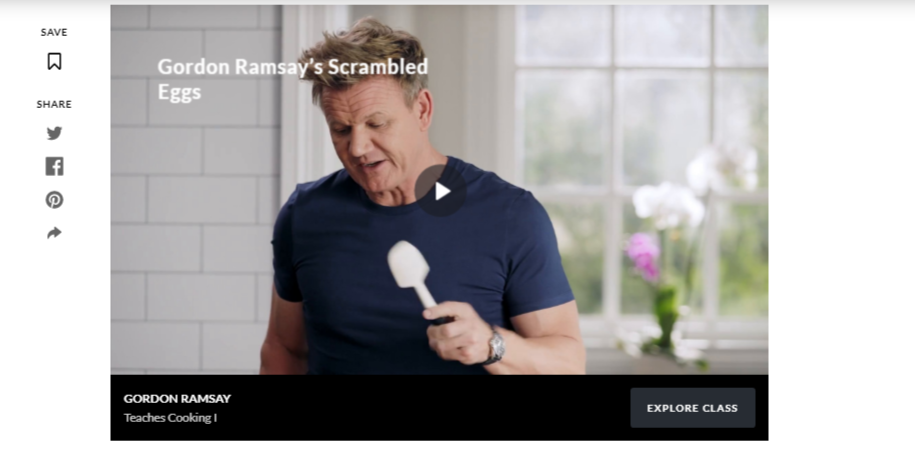
More and more people now prefer to learn about a product or brand by watching than by reading.
Wyzowl found that compared to 18% of people who prefer to read text, 66% would rather watch a short video.
That’s a huge untapped audience for any business still choosing to not invest in video today.
As a bonus, MasterClass also repurposes the video content they create for blog posts to grow their YouTube channel, and to capitalize on that free organic traffic from YouTube.
(If you aren’t marketing on YouTube yet, these 41 YouTube stats will change your mind.)
“If you do not subscribe to Foundation’s newsletter, you are missing out on a content marketing GOLDMINE.”
– Rachael Hensley, Director of PR and Comms at Shippo
In-Content Keyword Strategy
So if you fulfill search intent and deliver exceptional content, does it mean you shouldn’t care about your in-content keywords?
Absolutely not.
There’s still a place for strategic keyword placement to boost SEO and get found online.
Here’s an example of MasterClass’ in-content keyword strategy:

They know that their audience wants “soft,” “easy,” “homemade” pretzels, and they’ve mastered how to naturally incorporate those into headings.
Headings can be powerful triggers to help search engines understand your content.
When done right, they can be the difference between getting discovered faster and staying under the radar.
Based on the previous screenshot, you may feel like MasterClass is going overboard with keywords and getting rewarded for it, here’s what the headings really look like in the post:
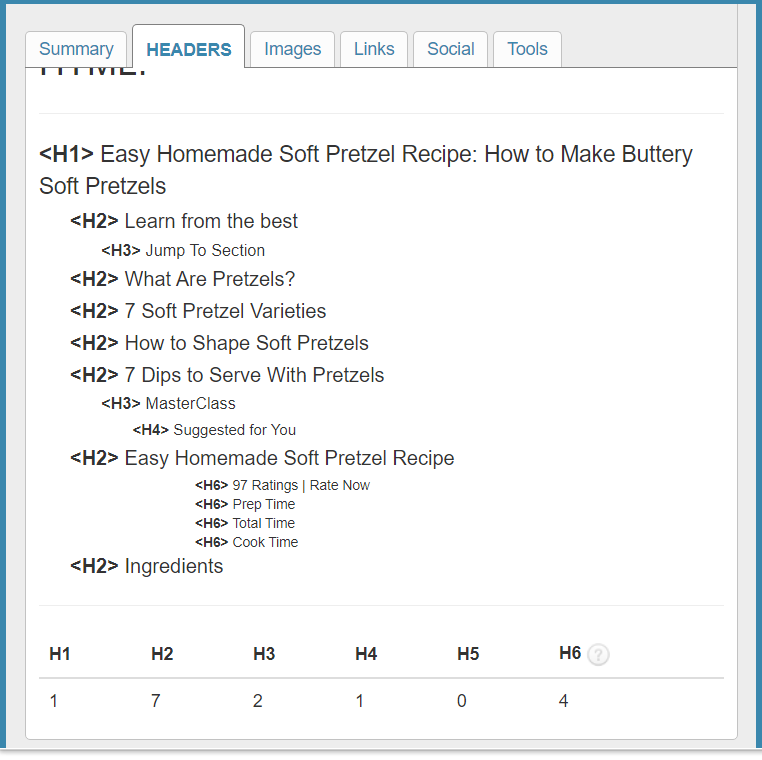
Completely natural and useful for navigating the content itself.
MasterClass As a Link Magnet: What Drives Their Linkability?
Links are some of the biggest ranking factors in 2022.
They do two things:
- Help search engines discover new pages
- Clue in search engines to useful, high-quality content
The more trustworthy the site linking out is, the more weight Google places on the link (or the trust recommendation).

(source)
MasterClass has succeeded in driving 648,000 backlinks from over 50,000 domains, including high-profile news websites like CNN, The New York Times, and The Guardian. Even more impressive is that they have backlinks from the Google domain itself!
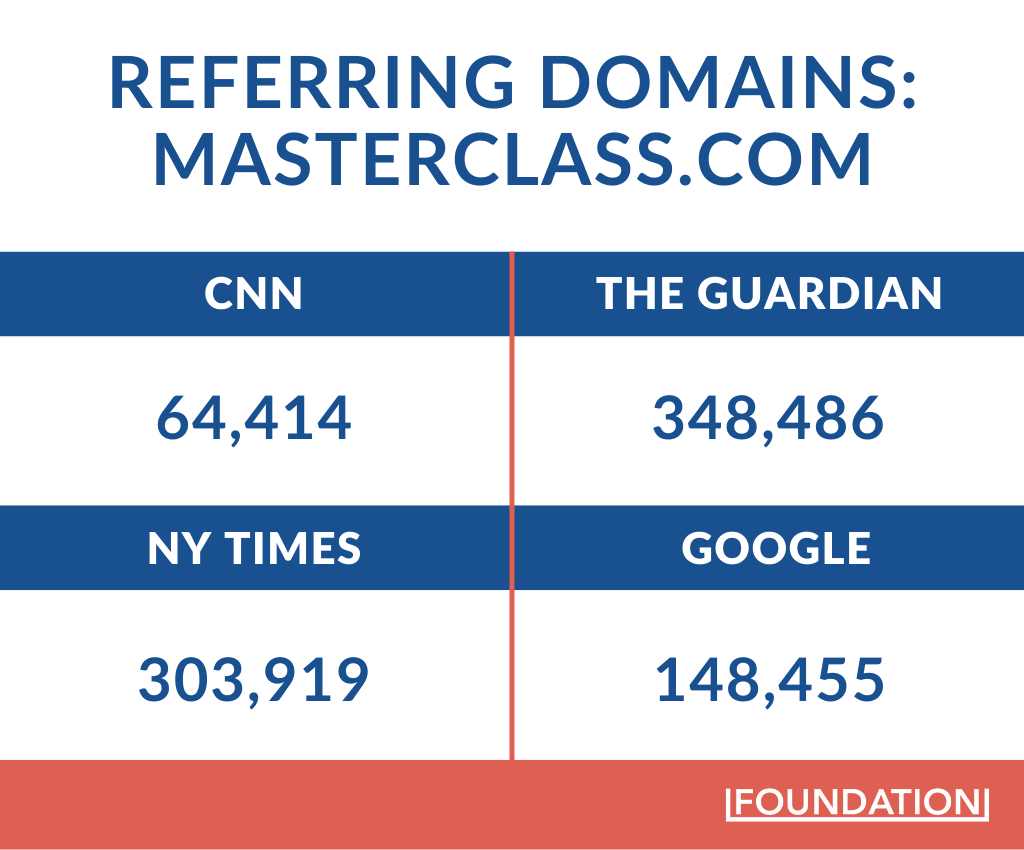
What makes the MasterClass website so linkable?
Here are 3 things that stand out:
- Post quality – MasterClass invests in high-quality content that is actionable and thorough, just like we teach in our Content Marketing Playbook. (Actually, there’s a particular type of content that’s great for attracting links—we’ll cover that toward the end.)
- Presentation – People link to blog posts that are good-looking and easy to read, not cluttered and disorganized. To make your posts more user-friendly, learn to write for the web.
- Authority – People are more likely to link to posts written by or featuring a topical expert. This is where MasterClass really excels: its celebrity instructors.
Social Proof & Linkability: The Celebrity Influence
MasterClass’ whole concept revolves around topical experts—people who are masters at their craft. But the secret ingredient is a few celebrity instructors who seriously boost brand awareness and linkability.
The celebrity influence helps with:
- Word-of-mouth marketing – Your neighbor is telling everyone how he learned to grow potatoes in a sack from Ron Finley.
- Social proof – “If so-and-so is involved, it’s got to be good.”
- Joint venture marketing – When Serena Williams tweets about her MasterClass, you better believe her large following will start taking the MasterClass brand a little more seriously.
In fact, some of the most linked-to pages are classes by celebrity instructors:
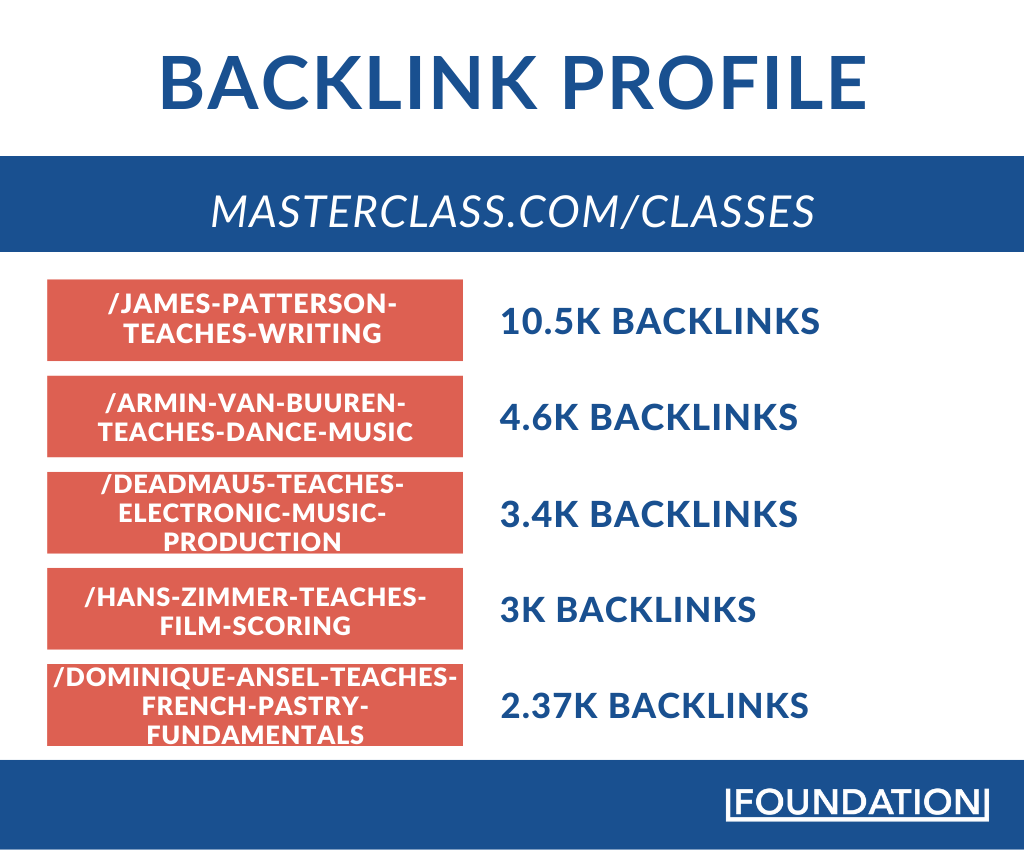
Simply put, the celebrity influence is working.
But the hack here isn’t getting Gordon Ramsay to collaborate for your SaaS website—it’s about leveraging the clout of top experts and authorities in your industry.
Get a few key people on board, then leverage those relationships for more impact, instead of focusing on everyone you can find.
And though this strategy may sound out of reach for small brands, it’s completely doable.
In his book The Ultimate Sales Machine, Chet Holmes explains how he used a tactic called the “Dream 100” to acquire dream clients and double ad sales for a million-dollar company in one year.
Basically, he closed his eyes to low-hanging fruit and went in hard after the big shots.
That’s the way it’s done!
But if going directly to the top people in your industry sounds scary (and it is), the “Expert Connection Map” technique can help.
When you reach one expert’s circle, the next “level” becomes more accessible to you.
This way, you aren’t wasting resources by aimlessly reaching out to anyone who will listen.
Here’s how it works:
1. Draw up your list of experts.

2. Grade them according to clout/authority/reach or whatever metric matters most to your business.

3. Map out the connections from you to the top experts. Doing this will allow you to determine the fastest route to reach them.

In a nutshell, find 5–10 people who will generate the biggest impact for your business, and strategically map the fastest route possible to reach them.
Inbound vs. Outbound Marketing: A Sweet Balance
It’s 2022, and no one is disputing the value of inbound marketing anymore.
Almost everyone knows now that the most effective way to win your audience over is to:
- Understand who the customer is and what they want.
- Create free value around that.
- Play the long game.
- Guide them through the purchase journey.
MasterClass has excelled at this and, as we’ve seen, is absolutely killing it in search.
But does it mean there’s no more place for outbound marketing?
Not for the MasterClass team—and if you want to survive the internet today, not for you either.
MasterClass strikes an exemplary balance between inbound and outbound marketing.
And here’s why you should too:
The biggest drivers of organic traffic are all cutting reach.
Google, Facebook, Pinterest—they’re all focusing on keeping people on the platform.
Take a Google search for the term “blue hex code” for example:
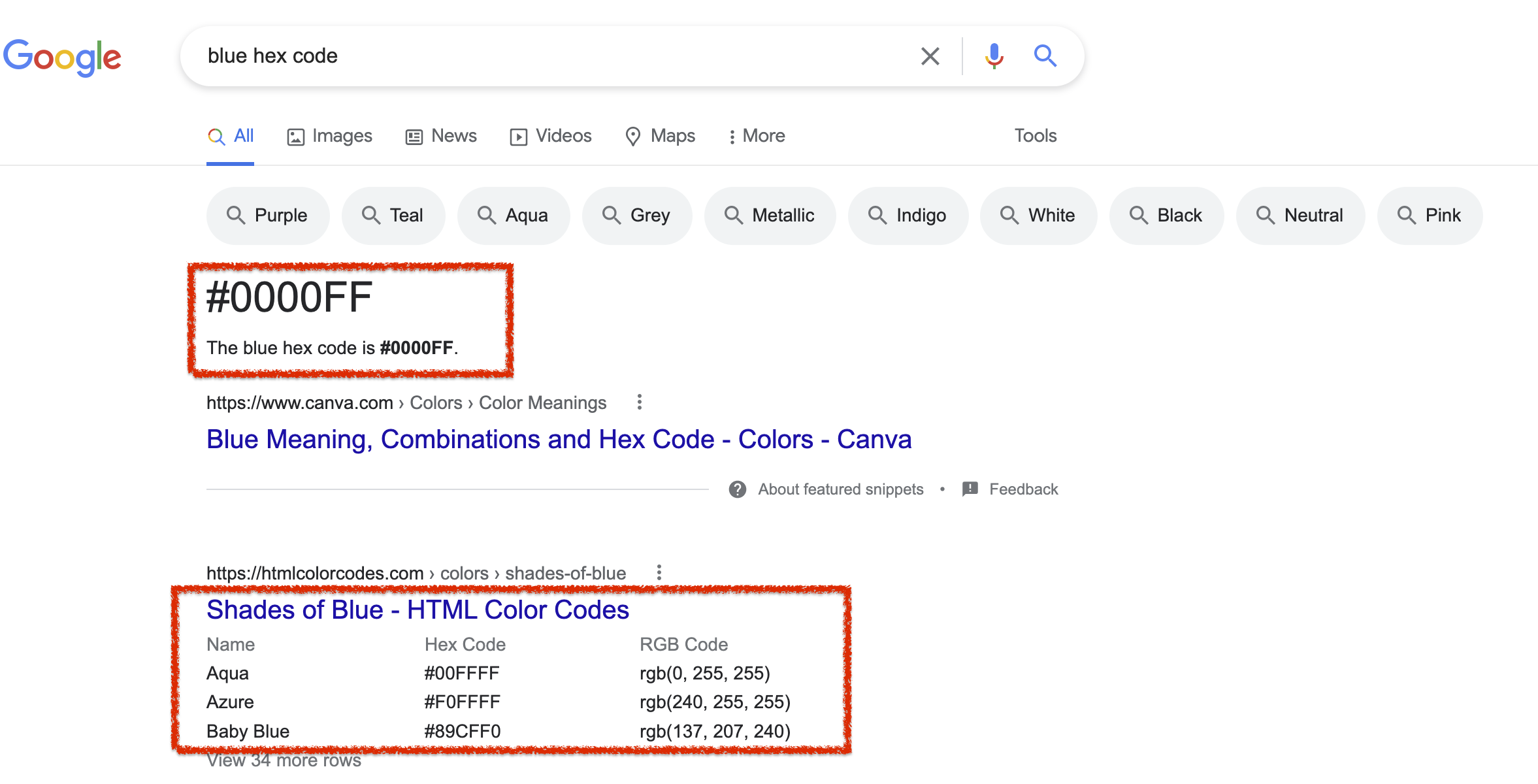
Google literally pulls the response from a website and displays it on their platform. No need to click through!
It’s even worse for Social.
Facebook, especially, has drastically dropped its organic reach for business pages. It’s a miracle to get more than 2% reach these days.
Long story short, the game has changed—it’s now pay-to-play, and MasterClass knows that. If they’re paying so much to run ads as we’ll see in a bit, it’s because it’s working.
Let’s take a look!
Brilliant Ads & Smart Remarketing for the Win
Admit it: You’ve been enthralled by a MasterClass ad before.
Even if you didn’t take out your credit card, you probably watched till the end and suddenly had a strong urge to become a screenwriter or a master gardener.
And it’s not just you.

People everywhere are captivated by these ads.
We love them too! In fact, if we had to pick the one thing we love most about MasterClass’ marketing strategy, it would be their ads.
We all have something to learn from them here.
Take this Gordon Ramsay MasterClass pre-roll ad for example:
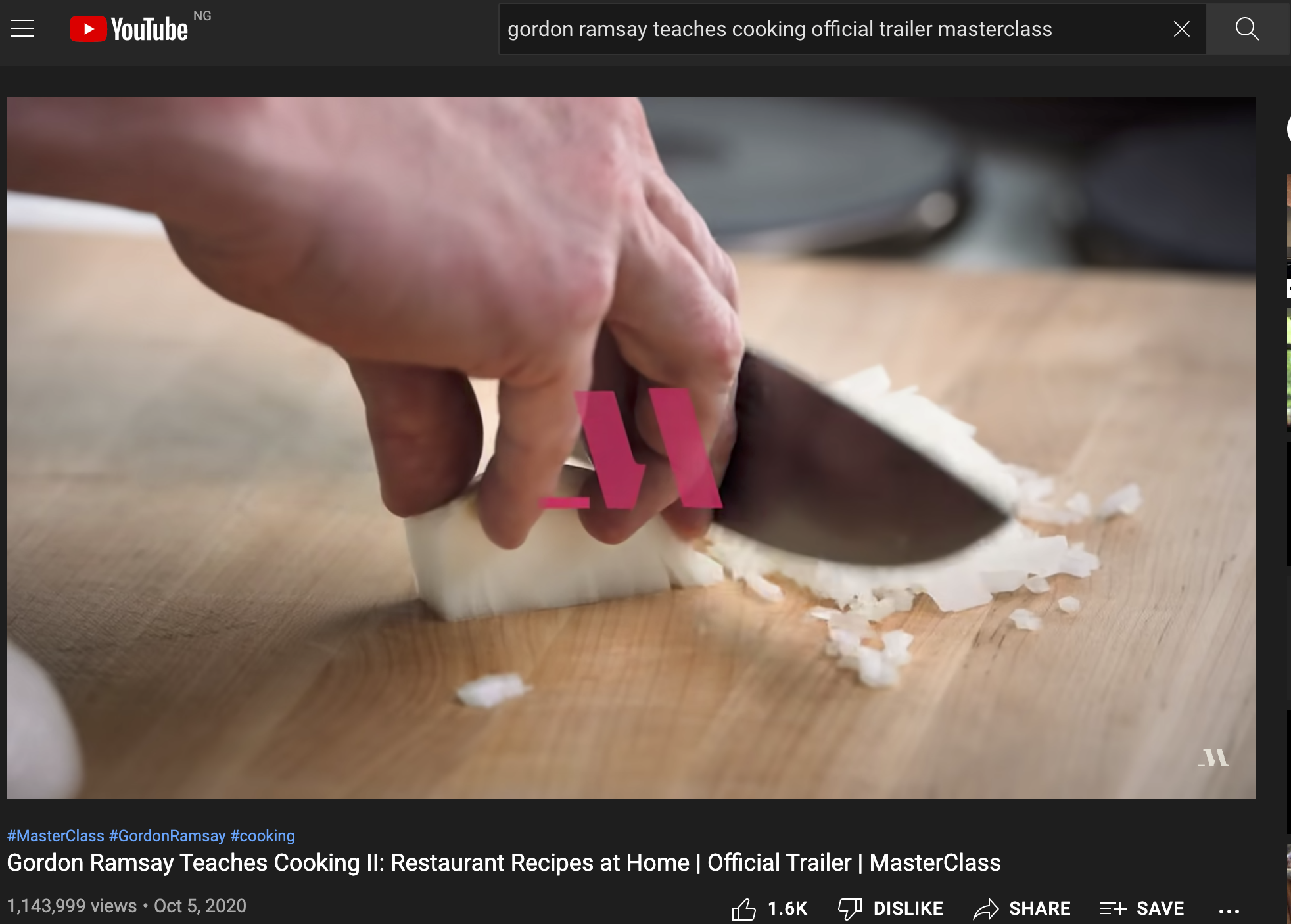
He dices an onion and then says, “Watch carefully.”
Next thing you know, you are salivating over a raspberry soufflé as he delivers this memorable message: “The art of food is something anyone can master once you know the right thing to do. And I’m the best teacher to show you.”
You forget you’re watching an ad. It feels more like a trailer for a really good movie. And that’s intentional—in fact, MasterClass calls their ads “trailers.”
What Movie Trailers and MasterClass Ads Have in Common
Just like good movie trailers, MasterClass ads…
- Entertain
- Educate
- Move at a fast pace
- Promise an experience
- Leave you wanting more
If you don’t feel like you’re being sold to, then the ads are working like they’re supposed to.
Cofounder Aaron Rasmussen told The New York Times:
“There really is a format to it…with a joke and a buildup, a sensitive moment that’s sometimes painful, then the contrast to the rising end of the trailer that brings us into, ‘I’m so-and-so, and this is my MasterClass.”
If we break down Rasmussen’s summary, here’s what we find:
- Humor – The MasterClass ads promise that you won’t get bored to death with their courses.
- Connection – The ads let you in on the challenges the instructor has faced—challenges you may be facing too, challenges that cast the expert as a relatable human being.
- Hope – If they can do this, you can do it too, and you have them to show you how.
Overall, they sell an experience rather than a product.
Brand Awareness vs. Product Awareness
Let’s say you want to invest in a product offered by multiple companies. Who would you rather buy from—a well-known brand or one you’ve never heard of before?
Whether we like it or not, brand awareness has to be a priority for small businesses. And one of the fastest ways to build awareness for your brand is through paid advertisements.
In fact, most MasterClass ads actually promote brand awareness more than product awareness.
While “awareness” is not necessarily a metric you can measure, it’s super important that new brands optimize ads for brand awareness rather than simply selling a product.
One key way that MasterClass uses brand awareness to its advantage is to foster trust.
When MasterClass shows you their ads, they aren’t just telling you to buy a course taught by your favorite instructor. They’re saying, “This is MasterClass, the brand that creates educational products you can trust.”
The result?
MasterClass’ pricier yearly membership did so much better than its individual course fees that they discontinued the latter.
Brand awareness is also the only reason why somebody performs a search with the brand name in it, asking Google for results from that domain.

That’s a powerful quality indicator for Google.
Tying Up Loose Ends With Remarketing
So MasterClass’ ads focus on creating brand awareness more than product awareness—that doesn’t mean MasterClass is not trying to sell their offering too.
Last week I was on the MasterClass website looking at the Annie Leibovitz photography class. I log into Facebook a day later, and what do I see?
An Annie Leibovitz MasterClass ad!
Same thing on YouTube and everywhere else I go.
Coincidence?
Not.
When we check Moat, we see that they are running ads for all the instructors, not just Annie.

The company is investing millions of dollars in page-specific remarketing—and it’s obviously working.
Intent-Based Marketing
Read any post by MasterClass, and you’ll find something like this early on:

Scroll further down and you are greeted with a bigger, bolder autoplay ad featuring another relevant instructor:

MasterClass’s one goal is to sell its membership subscription.
To do so, they don’t spend time writing blog posts that target random high-volume keywords.
Every single blog post on MasterClass’ website forms a part of their top-of-funnel strategy—a strategy built on intent-based marketing.
Intent-based marketing starts with two questions:
Who is the prospect?
What are they interested in?
For instance, MasterClass has a lineup of cooking classes, including:
- Knife skills with Gordon Ramsay
- Cooking beef short ribs with Thomas Keller
- Cooking eggs with Gordon Ramsay
So they write articles that rank in the top 3 for things like “What is a shallot?” which presells a Gordon Ramsay knife skill class for—you guessed it—cutting a shallot correctly.
They also have an article ranking for “how to cook short ribs” that promotes Thomas Keller’s class. Want to learn “how to cook over-easy eggs”? MasterClass is ranking there too and selling several Gordon Ramsay classes in the process.
They use this same strategy across all their different topics:
- Writing and literature
- Business and sales
- Sports and games
- Film and TV
Everywhere.
It’s easy to get caught up in vanity metrics like traffic, but unless advertising is your main revenue stream, who you attract matters much more than how many people you attract.
Intent-based marketing is the reason targeting even exists for ads.
People only want to see what they want, or at least what they think they want.
Reactive Storytelling: Giving People What They Think They Want
Interrupting people with ads for an offering they aren’t interested in is not merely pouring resources down the drain—it’s creating a negative connotation for your brand.
However, there’s one loophole smart marketers use to get in front of people who typically wouldn’t be interested in their offering.
That loophole is context.
Remember this ad from Mother’s Day? It was a MasterClass/Forbes collab urging us to “Give Mom the gift of a year’s worth of picking up new skills…”

If ballet is not your thing and you had seen this offering on a normal day, you might have been put off. But MasterClass used Mother’s Day as an “in” to hold your attention.
That is reactive storytelling at its best.
And it works for more than just ads. People can’t resist content that relates to whatever is going on around them at the moment.
They will talk about it, link to it, and share it in order to feel like a source of new and relevant information.
Here’s how to capitalize on this loophole.
1. Listen
To be able to create reactive content, you need to have your ear to the ground.
Use social media, content feeds aggregators, and custom alerts to monitor what’s trending in your industry and the world at large.
Some good listening tools include:
If you click the settings button in the Twitter “Explore” tab, you can personalize your trend recommendations based on your location and who you follow.

It’s also smart to follow industry experts, as they often monitor and tweet about trends. For example, here’s a list of 70+ marketers to follow on Twitter if you want to stay abreast of trends.
2. Find a brand-relevant angle
Once you’ve found a worthy trend, the next step is to tie it to your brand.
Some great angle examples for MarTech we’ve seen:
- What Can We Learn From Coca-Cola’s Global Marketing Success?
- What Innovative Marketers Can Learn From Taylor Swift
- Why Kim Kardashian Is the World’s Best Marketer
3. Act fast
This is one place where being the first will trump being the best 90% of the time.
To capitalize on trending topics, you need to strike while the iron is hot. Don’t worry so much about getting it perfect as about getting it out there.
Finally, always avoid potentially triggering topics like politics, tragedy, or any other sensitive topic your audience may react negatively to.
Case Study: MasterClass & The Gangsta Gardener
Speaking of reactive marketing, MasterClass recently launched a gardening class.
The timing couldn’t have been better.
It was spring—the sun was shining, gardens were blooming, and people quarantined at home were desperately looking for new hobbies. What better than a virtual class that gives you something interesting to do AND teaches you to grow your own food at the same time?
But it wasn’t just the timing that made the gardening class a hit.
MasterClass is a master at content distribution. They don’t build it and just hope that people come.
From Facebook to Twitter to Instagram to YouTube and even blogging, MasterClass invests in generating enough awareness to make their content go viral.
Just look at that spike!

So how did they do this for their gardening course?
1. Shared on Twitter
Within one week, MasterClass shared four tweets related to Ron Finley and the gardening MasterClass.
These weren’t repetitive tweets with no value, but lively tweets with bold images or a video, each taking a different angle.
2. Shared on LinkedIn

The best part is because they had already invested in video marketing, all they had to do was repurpose their video content for social media.
Videos do really well on social media too. See the number of views?
3. Emailed Their Followers
The people on the MasterClass email list want to hear from them, so that’s exactly what the company did when they published the new course.
4. Leveraged Influential People & Websites
Around the time when the course came out, almost all the influential websites carried the news. CNET, Yahoo Lifestyle, AskMen, Apartment Therapy—they were all buzzing about it.
But it wasn’t a mere coincidence. A look at CNET’s links reveals an affiliate relationship.
What can you give influential people to get them talking about your content?
Links, a higher affiliate commission, or even payment.
5. Used Webinars & Livestreams
The first week after launch, MasterClass also held a YouTube Livestream with Ron Finley to build interest.
While these are just five tactics—not necessarily everything that MasterClass did—the possibilities for strategic content distribution are endless.
For instance, MasterClass has also been answering relevant questions on Quora (one of the distribution channels we recommend) to draw attention.

And more recently, MasterClass asked people to vote for their favorite skateboarding tricks to promote their newest course, a Tony Hawk skateboarding class.
It is with great pleasure – and awkward hesitation – to present winners of the @masterclass NBD / Best Trick Challenge according to your votes. I will divide my prize money between the other competitors because I appreciate them agreeing to participate in this experimental format pic.twitter.com/LvOx2lX4oj
— Tony Hawk (@tonyhawk) June 29, 2020
At five hours in, this tweet generated 1,000 likes and 141 retweets.
Impact & Disruption: Lessons To Be learned
One of the key lessons we can learn from the MasterClass team is how to create a brand that sells itself.
The founders of MasterClass succeeded in disrupting the e-learning industry.
In what ways can your business differentiate itself? What can you do to stand out?
MasterClass’ brand story is that they make it possible to learn from the very best. But their story wouldn’t be nearly as effective if they didn’t go in 100% with a high-quality experience.
You can make this work for your brand too.
Here are three angles to try:
- New – Be the first to use an original and innovative idea. Remember how infographics disrupted the market when they first came out?
- Noble – Be the brand that cares deeply about the environment, pets, or something else.
- Complete – Be the one-stop-shop, the brand that produces the complete experience.
Or simply go the extra mile when you do what you’ve always done, and be known for going the extra mile.
You can apply this tip to your free content too.
When almost everyone is regurgitating and beating out the same old topics in the same way, going the extra mile will help you stand out by a lot.
Re-evaluating To Grow
MasterClass launched in 2015 and despite its early success in sales, it wasn’t until two years later that it began to see any worthwhile organic growth.
And only in 2019, another two years later, did things really begin to skyrocket.
While it’s true that SEO takes time, for a company getting the kind of buzz MasterClass was getting those first four years, something seems off.
A quick look at the web archives reveals that up till early 2019, MasterClass had no real blog.
What they called their blog was in fact just a company journal set up on the subdomain news.masterclass.com, a telltale sign of what blogging meant to the MasterClass team at the time.
Fast forward to 2019 when they started to publish informational blog posts, and we see an immediate and substantial uptick in traffic.
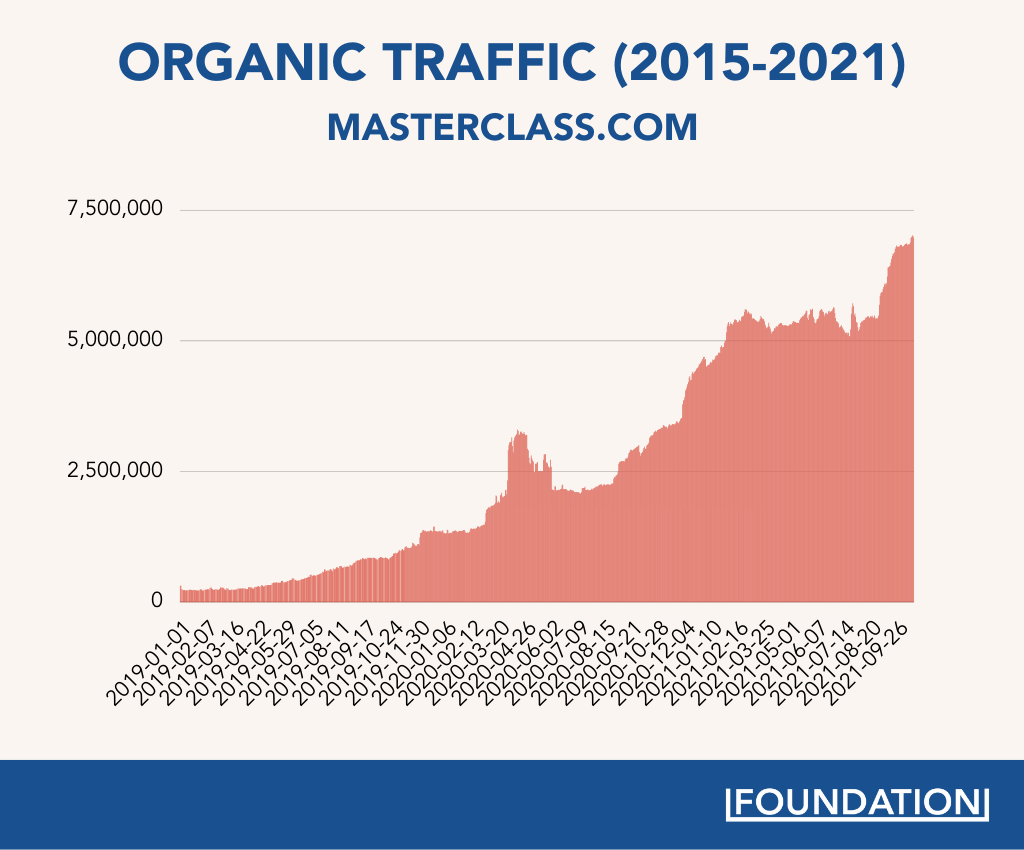
If your business still doesn’t have a blog, now is the time to start.
By implementing blogging—and targeting the right keywords with high-quality content— MasterClass was able to 8x their organic traffic within a year!
[HACK] Original Linkable Assets: The MasterClass Loophole for Small Businesses
It’s no longer an option to republish content from other sites and expect it to rank, true.
But should you stop at just writing your own take on a topic?
Not if you want to create link magnets.
MasterClass may not need this angle since they have celebrity power working for them, but it could be an absolute game changer for small businesses.
What types of content serve as the best link magnets?
Stats, reports, comprehensive how-tos, ultimate guides, and the winner by a long shot in the MarTech space, tools.

Tools can be costly to build, but they help your audience take action. They aren’t complex data that promise to help—they help right away, and people clearly appreciate that.
Take Neil Patel’s blog for instance. The URL with the highest number of referring domains is his keyword research tool Ubersuggest with 26,606 referring domains.
That just goes to show how powerful tools are for attracting backlinks—especially free tools. But you don’t have to put out thousands of dollars to create a highly linkable tool. You can create linkable assets.
Here at Foundation, we’ve had success with detailed stat collections. Take this one, “50+ LinkedIn Statistics Marketers Need To Know In 2022.” The post has earned 2,600 backlinks from 1,260 domains.
Imagine what you can achieve with just a handful of these linkable assets.
Wrapping Up
MasterClass’ success is unconventional—they’ve had the unique advantage of celebrity power to help them grow.
But remove all the fancy videos and celebrity glamour, and what we really have is backlinks, exceptional content, and intent-based marketing.
That right there is a formula for fast and sustainable growth.
Will it be as easy to drive powerful backlinks without celebrity influence? No, it won’t. But that doesn’t mean it’s not doable. For your brand, taking a page from MasterClass’ book may be about getting a few key experts and leveraging those relationships to gain a broader reach.
It’s about mastering inbound marketing and leveraging outbound marketing to create brand awareness and a memorable brand experience for your ideal audience.
Want to learn how to completely reverse-engineer your competitor’s content and SEO strategy? Check out our Sherlock Homeboy strategy article next.
Quick, do it now before the next drop!







